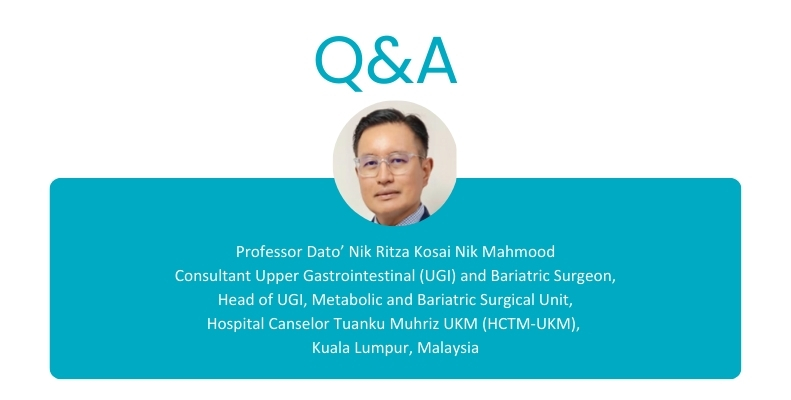NEWS & PERSPECTIVE
Malaysia’s first ESG in a public teaching hospital marks a new era in obesity care
Malaysia continues to face a rising burden of obesity, with more than 54% of adults classified as overweight or obese.1 In response, Hospital Canselor Tuanku Muhriz UKM (HCTM-UKM) introduced endoscopic sleeve gastroplasty (ESG) into the public healthcare sector earlier this year. It became the first government and teaching hospital in Malaysia to offer the procedure, an effort led by Prof. Dato’ Dr. Nik Ritza Kosai, head of upper gastrointestinal (UGI), metabolic and bariatric surgical unit at HCTM-UKM.2 ESG addresses a critical treatment gap—while lifestyle modification and pharmacological therapies often yield modest or short-lived results, many patients are reluctant to undergo conventional bariatric surgery due to its invasive nature and potential risks.3,4 As a minimally invasive approach, ESG offers an alternative for individuals with mild to moderate obesity serving as a middle ground between pharmacologic therapy and surgery.4,5
ESG is a transoral endoscopic procedure that reduces gastric volume by approximately 50%, achieved through the placement of full-thickness sutures using a specialized device introduced via upper endoscopy.4,6 The stomach is reshaped into a narrow, sleeve-like configuration to limit the volume of food intake and promote satiety with smaller meals.4,6 The technique avoids external incisions or tissue removal, while preserving key anatomical structures.4
Within the therapeutic spectrum, ESG occupies a niche between pharmacologic therapy and conventional bariatric surgery.5 It is the preferred option for patients with a body mass index (BMI) between 30kg/m2 and 37.5kg/m2.5 Evidence indicates that ESG can lead to total body weight loss (TBWL) of 15%-20% within the first two years, with sustained results: at five years, the mean TBWL remains 15.9%, with 90% of patients maintaining at least 5% TBWL, and 61% achieving at least 10% TBWL.7 Although weight loss outcomes are generally less pronounced than those seen with bariatric surgeries, ESG is associated with significant and clinically meaningful improvements in obesity-related comorbidities such as type 2 diabetes, hypertension, and fatty liver disease.3,6
ESG also demonstrates a more favorable safety profile than bariatric surgeries.8 Serious adverse events, such as gastrointestinal bleeding or perigastric fluid collections are rare, occurring in fewer than 2% of cases.8 Post-procedural symptoms like nausea, abdominal discomfort, and heartburn tend to be mild and self-limiting.8 Unlike laparoscopic sleeve gastrectomy (LSG), ESG typically enables same‑day discharge with minimal early in‑hospital complications, promoting a faster and smoother recovery.8 Notably, ESG does not appear to increase the risk of gastroesophageal reflux disease (GERD), likely due to the preservation of normal gastric anatomical structures—including the angle of His, autonomic nerve pathways, and antral function—which collectively help maintain normal esophagogastric physiology.3,8 Given its markedly safer profile, ESG is increasingly viewed as a more favorable risk-benefit alternative, particularly for obese patients in the lower BMI range.6,8
Looking ahead, ESG is expected to play a growing role in the landscape of obesity treatment.3 According to Prof. Nik Ritza, as procedural expertise expands, ESG may become a viable mainstream option for selected patients, particularly when combined with pharmacologic agents including glucagon-like peptide-1 (GLP-1) receptor agonists post-procedure to enhance efficacy.7 Its minimally invasive nature, favorable safety profile, and potential synergy with adjunct pharmacologic therapies position ESG as a strategic tool in addressing Malaysia’s escalating obesity crisis.4,7,8
In an interview with Omnihealth Practice, Prof. Dato’ Nik Ritza Kosai Nik Mahmood, the head of UGI, metabolic and bariatric surgical unit, HCTM-UKM, shared his practical insights into the post-procedural care, systemic challenges, and clinical messaging surrounding the introduction of ESG in Malaysia.
Q1: What are the key components of the post-ESG care protocol, and how do they contribute to long-term patient success?
Prof. Dato’ Nik Ritza Kosai: Post-ESG care is essential to achieving meaningful, long-term outcomes. The procedure itself is just the starting point—what follows is equally, if not more, important. We implement a structured care protocol involving dietitians, clinical psychologists, and other specialists who work together to support the patient through every stage of lifestyle transition. This includes a phased dietary plan, early and progressive physical activity, and ongoing behavioral support to address emotional eating, build motivation, and reinforce healthy habits. Ultimately, the success of ESG depends on the patient’s commitment. The procedure is only a tool—sustained results require long-term lifestyle change.
Q2: What are the main barriers to broader implementation of ESG in the Malaysian healthcare system?
Prof. Dato’ Nik Ritza Kosai: One of the most immediate barriers is cost, particularly as ESG is not yet included in the national bariatric guidelines and therefore remains unreimbursed. In addition, the procedure demands a high level of technical expertise, and local training capacity is still in its early stages. Awareness remains limited among both healthcare providers and the public, with many perceiving obesity treatments as a binary choice between medication and surgery—overlooking ESG as a viable option. Fundamentally, broader uptake will depend on formal policy inclusion, insurance coverage, and the establishment of training and awareness initiatives to bridge this gap in care.
Q3: How would you position ESG to clinicians and the public who may be unfamiliar or uncertain about its role in obesity care?
Prof. Dato’ Nik Ritza Kosai: ESG is not meant to replace surgery, but rather to expand the range of options available in obesity care. For patients who are not ideal surgical candidates—whether due to a BMI below the threshold for bariatric surgery, existing comorbidities that raise surgical risk, or personal preference—ESG provides a safe, minimally invasive, and evidence-based alternative. Still, ESG is only part of the solution. Long-term success in obesity management begins with prevention, and while ESG and similar interventions can offer meaningful outcomes, our ultimate goal should remain the prevention of weight-related complications before they develop.


